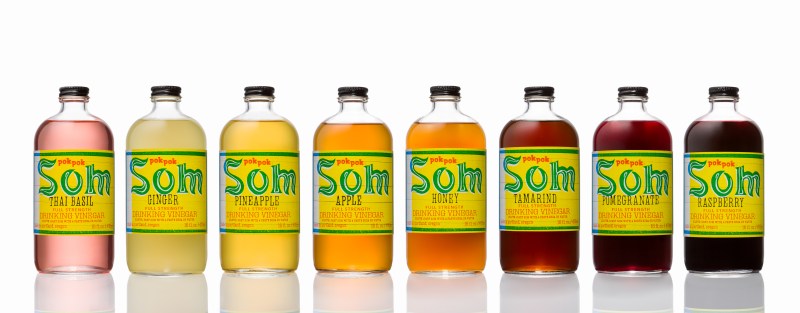
On their own, drinking vinegars are a great alternative to sugary drinks like soda. In cocktails, shrubs are often used to replace citrus, as shrubs do not cloud when shaken in a drink.
If you’re interested in trying drinking vinegars, there are a couple that you can pick up in stores or online.
Pok Pok Som Chef Andy Ricker of Pok Pok fame created Pok Pok Som in 2005 for use in specialty cocktails. Customers loved it so much the restaurant began serving it with a splash of soda water on the rocks. Som comes in a variety of flavors, from ginger to apple to rhubarb and tamarind. Nothing is ever too sweet so even the sweeter-sounding flavors won’t make you feel as if you’re drinking syrup. New York City’s PDT recently used Pok Pok Som in a specialty cocktail. Ask for the Som Collins.
Genki Su Drinking vinegar has long been a tradition in Japan, dating back to feudal times. Genki Su, created by Japanese-American Takako Shinjo, offers four varieties of handcrafted drinking vinegars flavored with fruit and herbs such as apple and shiso (a Japanese herb similar to mint) and sweetened with honey and Stevia, making them a low-calorie alternative to soft drinks.
McClary Brothers Michigan-based McClary Brothers uses local herbs and fruit in its drinking vinegars, which are made in small batches. The apothecary-style bottles hold a selection of specialty flavors including pineapple and fennel, apple pie, and rhubarb. Seasonal flavors rotate throughout the year and most are tart with a bit of an earthy undertone. McClary suggests mixing the vinegars with bourbon, whiskey or rum for cocktails, or soda for a healthy tonic.
Suja Organic and non-GMO, San Diego, California-based Suja’s drinking vinegars are cold-pressed juices, made from a mixture of apple cider vinegar and coconut vinegar, and come in eight different flavors, including flavors like Strawberry Balsamic, Lemon Cayenne, and Ginger Turmeric.
Or, for the adventurous and creatives ones out there, you can make your own. Michael Dietsch’s book Shrubs is a perfect introduction into the beverage in addition to giving plenty of recipes for how to make them.
(Updated on 1/17/17)


